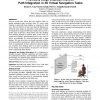Free Online Productivity Tools
i2Speak
i2Symbol
i2OCR
iTex2Img
iWeb2Print
iWeb2Shot
i2Type
iPdf2Split
iPdf2Merge
i2Bopomofo
i2Arabic
i2Style
i2Image
i2PDF
iLatex2Rtf
Sci2ools
114
click to vote
CHI
2004
ACM
2004
ACM
Physically large displays improve path integration in 3D virtual navigation tasks
Previous results have shown that users perform better on spatial orientation tasks involving static 2D scenes when working on physically large displays as compared to small ones. This was found to be true even when the displays presented the same images at equivalent visual angles. Further investigation has suggested that large displays may provide a greater sense of presence, which biases users into adopting more efficient strategies to perform tasks. In this work, we extend those findings, demonstrating that users are more effective at performing 3D virtual navigation tasks on large displays. We also show that even though interacting with the environment affects performance, effects induced by interactivity are independent of those induced by physical display size. Together, these findings allow us to derive guidelines for the design and presentation of interactive 3D environments on physically large displays. Categories and Subject Descriptors: H.5.1 [Multimedia Information Systems...
CHI 2004 | Human Computer Interaction | Large Displays | Spatial Orientation Tasks | Virtual Navigation Tasks |
Related Content
| Added | 01 Dec 2009 |
| Updated | 01 Dec 2009 |
| Type | Conference |
| Year | 2004 |
| Where | CHI |
| Authors | Desney S. Tan, Darren Gergle, Peter Scupelli, Randy Pausch |
Comments (0)

